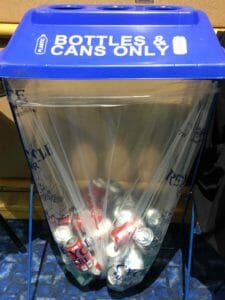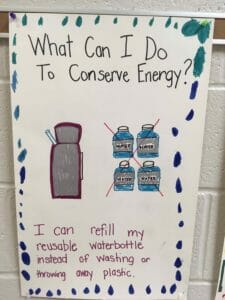(NOTE: I first wrote “Loving the Environment for Kids: My Top Five Tips for Raising Eco-Friendly Offspring” as a guest post for The Everyday Ecologist in June 2016. Since it’s no longer available on that website, I’m republishing it here with a few updates while I’m traveling. Enjoy! – Flossie)
What do your kids know about being eco-friendly? Like many things they’ll learn in life, lessons on the environment for kids start at home.
If you’re reading this, you’re probably someone who’s already doing more to raise eco-friendly kids than you realize. But maybe this list includes something you haven’t tried yet. If so, what have you got to lose?
Five Lessons on Loving the Enviroment for Kids:
1. Get your kids outside.
 Yes, they’ll need sunscreen and bug repellent (or even better, clothes with permethrin). Yes, where you live can make this hard. But even my husband, a born-and-bred city dweller, craves time in nature. For that, he has his parents to thank. Parents who took him hiking and camping, encouraged his bike-riding, and got him into Scouting.
Yes, they’ll need sunscreen and bug repellent (or even better, clothes with permethrin). Yes, where you live can make this hard. But even my husband, a born-and-bred city dweller, craves time in nature. For that, he has his parents to thank. Parents who took him hiking and camping, encouraged his bike-riding, and got him into Scouting.
Why make time outdoors a top priority? For starters, how will kids learn to love the environment when they don’t spend any time outside enjoying nature?
Even if your goal isn’t to raise the next eco-warrior, scientists agree that time in the environment for kids brings tons of benefits. Besides getting them to exercise, unstructured outdoor playtime can teach children everything from conflict resolution and resilience, to creativity and risk management. It can even help kids avoid vision problems later in life. (And it’s a great way to destress for adults and kids alike.)
By the way, Girl Scouting and Boy Scouting are still great ways to learn about the environment for kids. Kimmie loved her first Girl Scout day camp experience last summer. This year it’s Essie’s turn to try Girl Scout day camp, and Kimmie can’t wait to sample sleep-away Girl Scout camp for a few nights.
2. Postpone your kids’ introduction to screens, then minimize their screen time.
 How will your kids learn to love the outdoors when they’d rather be glued to a device? It’s one thing for kids older than two to experience Screen Hypnosis while you fix dinner. It’s another thing when all they want to do is play tablet or smartphone games.
How will your kids learn to love the outdoors when they’d rather be glued to a device? It’s one thing for kids older than two to experience Screen Hypnosis while you fix dinner. It’s another thing when all they want to do is play tablet or smartphone games.
We don’t subscribe to cable or satellite. Instead, our kids watch DVDs and (gasp!) VHS tapes on our old TV. Our family’s tech devices are strictly grownup work tools. Yet amazingly, our kids have learned to read and do math without smartphone apps or tablet games teaching them how.
Screen time’s downsides go way beyond spending less time outdoors. Studies have linked increasing screen time for children to greater obesity rates, less sleep, higher rates of psychological challenges, and lower levels of cognitive development.
I realize that doing without electronic pacifiers makes parenting more challenging. Just remind yourself that you’re doing it for your kids.
3. Recycle the obvious stuff.
 In some places, recycling even uneaten food scraps is mandatory. In other areas, municipal recycling programs are practically nonexistent. Thus, for some, recycling is as simple as following local ordinances. For others, recycling requires extra effort and creatively rethinking daily habits.
In some places, recycling even uneaten food scraps is mandatory. In other areas, municipal recycling programs are practically nonexistent. Thus, for some, recycling is as simple as following local ordinances. For others, recycling requires extra effort and creatively rethinking daily habits.
If you don’t currently recycle anything, one easy way to start is by reusing the backsides of envelopes or printed-on-one-side-only paper for scratch paper or your children’s drawing habit.
On the other hand, if you find yourself regularly tossing food scraps or moldering UFOs (Unidentified Food Objects) from the depths of your fridge, maybe it’s time to start your own backyard compost pile, or find/start a community one. (And perhaps explore as a family why so much of your food spoils before it’s consumed.)
It takes commitment to bring spent fluorescent light bulbs, dead batteries, empty printer cartridges, and obsolete electronics someplace to recycle. But by doing it – and explaining to your kids why you’re doing it – you’ll teach them valuable life lessons.
4. Recycle the less-obvious stuff.
My late father, who grew up in the shadow of the Great Depression, lived by the adage “Use it up, wear it out, make it do, or do without.” It’s a hard lesson to live in a twenty-first-century world of planned obsolescence, but it’s worth the effort.
 Before you toss usable stuff you no longer need in the trash, see if you can figure out who else might use it. (Check this list for ideas of where to donate your excess, or consider consignment or online selling.)
Before you toss usable stuff you no longer need in the trash, see if you can figure out who else might use it. (Check this list for ideas of where to donate your excess, or consider consignment or online selling.)
And don’t be too proud to partake in the other end of upcycling. I rarely buy new clothes, books, or other gear for my kids if I can get something just as good for less at a consignment sale. I love exploring thrift stores, Habitat ReStores, and our nearest secondhand craft-supply store for bargains on stuff that works just as well as the full-price versions. My brother Evan, who lives hours from the nearest lumberyard, has even managed to upcycle used wood pallets into every kind of furniture you could imagine.
5. Teach your kids to mind their stuff.

During a recent phone chat with a dear college friend, she lamented the dearth of travel mugs in her cupboard, and the surplus of empty plastic bottles in her minivan.
Her family started the school year with a dozen travel mugs. However, her high school sophomore has an uncanny knack for bringing mugs of coffee to school and then misplacing said mugs. And while the whole family has fancy reusable water bottles, both she and her middle-schooler always seem to forget to bring them out of the house in the morning. As a result, they constantly find themselves buying disposable bottles of water, which then pile up in her vehicle.
My mother thinks I’m nuts for trying to teach my kids to be responsible for their own belongings, but it’s so much easier to teach them when they’re young. Less stuff misplaced or forgotten means less need to buy excess. And if this is an area where you also struggle, you can make it a family project to improve on this area together.
So there you have it! Building lessons on the environment for kids into your routine isn’t impossible, with a little mindful planning. Baby steps can really add up over a lifetime, and learning small doses in regular increments will help your kids learn to love the world around them – and want to protect it for generations to come.
NOTE: This site contains affiliate links. I may earn a small commission from any purchases made through affiliate links, at no additional cost to you. For more information, please read the full disclosure/privacy policy.


I love this! I think it’s so important to teach kids about the great outdoors. Right now, we are hitting close to 100F during the day, so if we aren’t in the pool, outside just doesn’t happen. but as soon as it cools off, we will be out a lot between riding bikes to school and cub scouts and family camping trips.
So lucky your schedule works for fall camping! My husband’s fall teaching schedule is even more insane than usual, but he basically has a long break all of Dec-Jan, so hoping to do some cabin-camping then…
A lot of great and guilt-free ideas here! Glad I’m not the only screen-time nazi out there! #heartandsoullinkup
This is great. #4 is an important one I always do! Thanks for sharing at #heartandsoullinkup
Great post! I think so much of this is by example. And AMEN to #5 teaching your kids to be responsible for THEIR OWN STUFF. Love that! 🙂 Thanks for sharing at #heartandsoullinkup
This is an awesome quick guide to the environment for kids! Thanks for writing it!
So glad you liked it – thanks for commenting! 🙂